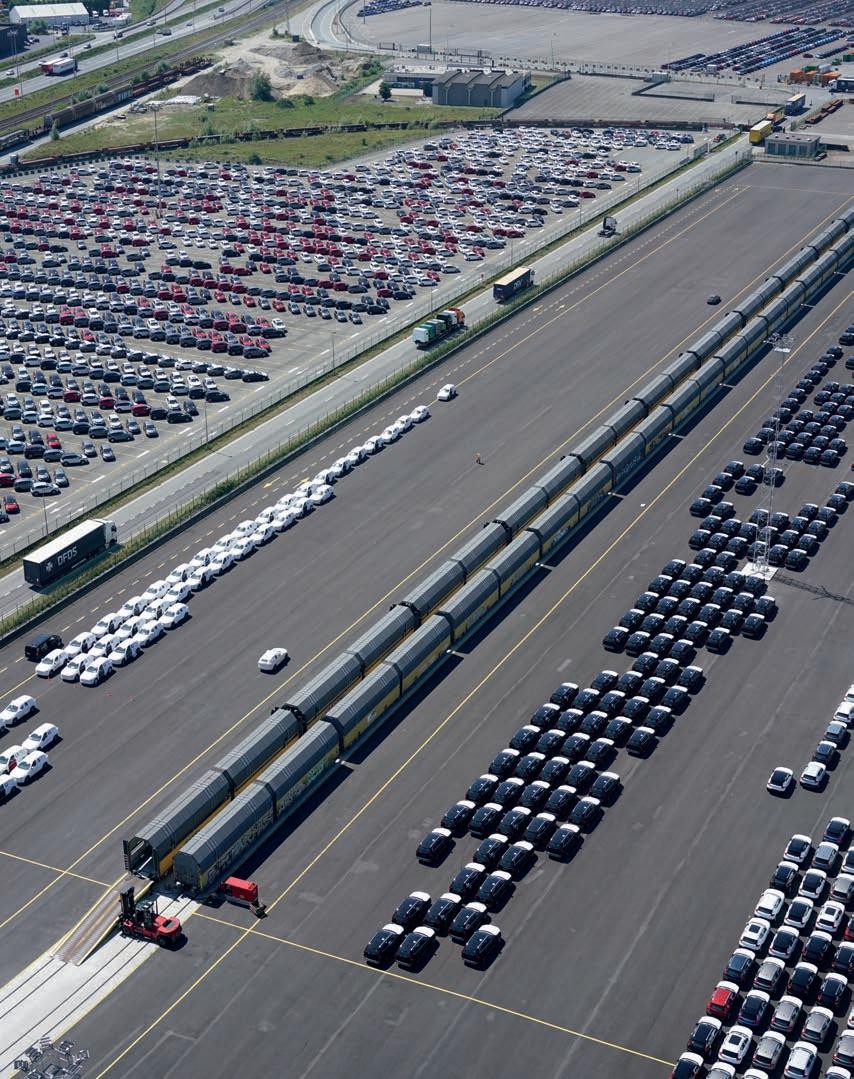
21 minute read
Volvo Cars, DFDS, Lineas
V6 rail terminal powers Volvo Cars’ multimodality drive
Train closely interacts with ship and truck
The new terminal makes the Volvo Cars logistics chain for fnished vehicles faster, more sustainable, and more cost-effcient.
With the new V6 train terminal at the Mercatordok, Volvo Cars has taken a major step in making its distribution logistics faster, more sustainable, and more cost-effcient. To achieve this, the car manufacturer cooperates with shortsea operator and terminal operator DFDS and rail freight company Lineas. “With the new set-up, we are taking 5,000 trucks off the road each year”, says Willem Talboom, Senior Manager Outbound Transportation at Volvo Car Gent.
North Sea Port is now the linchpin in a network for car logistics that extends from China to Belgium, and from Sweden to Italy and Austria, based on the close interaction between trains, ships, and trucks. The V6 terminal started operations in March last year. Volvo Cars invested several million euros to turn the 52,500m² facility into a full-fedged train terminal, equipped with two 320m tracks, for the reception and distribution of fnished vehicles produced by its own assembly plant in Ghent or arriving from its factories in China, Sweden, and the USA (via Zeebrugge). Two or three trains arrive at the V6 terminal at the Mercatordok every week with cars produced in China, while six to seven trains depart with cars made in Ghent, Göteborg, Charleston, Chengdu or Daqing. Two of them head for Italy (with Sacconago near Milan as fnal destination), two others go to Austria (where they unload in Schwertberg near Linz), and the fnal two or three return to China. The trains are run by Lineas, which has been a long-term Volvo partner for more than 20 years now. The rail freight company takes care of the frst and last mile in Ghent and works hand in hand with other operators for the long haul to the European hinterland and the Far East.
Strong growth of rail volumes
The capacity of each train averages 200 cars. The Chinese trains bring in Volvo XC60s assembled in the People’s Republic and take back different models produced in Europe. The other trains come in empty, the Austrian train returns after delivering cars of another manufacturer in Zeebrugge. The number of cars shipped by rail has gone up sharply in the past two years. In 2019, Volvo Cars received 19,400 cars arriving from China; the trains took 8,800 vehicles back for the Chinese market. The total on this route thus reached 28,200 cars transported by rail to, and from, Ghent. Last year, the total climbed to 45,600 cars. This is fve times more than the 8,700 cars which arrived by train from China in 2018, when the line started. The traffc with China remained more or less on par, slightly increasing to 29,130 cars. But the rail links to Italy (which started in 2019) and Austria (since 2020) provided extra volumes. They accounted for close to 16,000 cars. The new rise in 2020 was achieved despite the impact of the corona crisis on car sales in the frst semester, and which also affected Volvo Cars (global sales went down from 705,450 to 661,713 cars, a decline of 6,2%).
Photo courtesy of Volvo Cars.

Photo courtesy of Jean-Louis Vandevoorde.

Willem Talboom, Senior Manager Outbound Transportation at Volvo Car Gent. Volvo Cars uses both closed and open RoRo wagons to carry its cars. The open trains are destined for Italy and Austria, the closed one for the frst leg of the much longer journey to China (via Poland, where the cars are placed into 40-feet containers).
Showcase project
“Our train operations used to be scattered across different locations. We have brought them together on one single spot at a short distance from our assembly plant. The new location is not only right next to the DFDS terminal from where their RoRo ships shuttle back and forth six times a week to Göteborg, providing the backbone service for our logistics between our European production sites, but it also lies in the immediate vicinity of our marshalling yard which acts as a new car depot where trucks come to load and unload vehicles ready for distribution”, says Willem Talboom, Senior Manager Outbound Transportation at Volvo Car Gent. The advantages are many, he underlines. “Multimodality is one of the trump cards of North Sea Port, but this really is a showcase project. The new terminal brings water, rail, and road even closer together, and enables faster and more effcient multimodal combinations. We have been able to eliminate or shorten a lot of intermediate road transports. Cars coming from Sweden with the DFDS RoRo ships can be swiftly and directly transferred from their shortsea terminal to our rail terminal or shifted to the nearby marshalling yard to be picked up by a truck. In both cases, they only have to cover a distance of a few hundred yards. Cars from China can be temporarily stored next to the track or quay before being moved to the train or ship.” “By moving more cargo to the rail, we have also been able to substantially reduce the lead times for the delivery of our cars from factory to fnal destination. These lead times have been cut by up to 30%. For Chinese Volvo’s, trains only need 20 to 25 days to travel from Xi’an to Ghent. This trip would take almost twice as long by ship. Trains to Italy and Austria will arrive within just two days.”
“There is an ecological beneft, too. The train is not only a very reliable, but also a less polluting transport mode, as it emits nine times less CO2 and eight times less air pollutants than road transport. Our new set-up annually keeps no less than 5,000 trucks – up to 150 a week – off the roads. This is a major gain in our ambition to become greener.”
Part of a larger strategy to cut emissions
The shift to rail is indeed part of Volvo Cars’ larger strategy to cut emissions in its logistics network by switching transports from trucks to trains, especially in Europe where road haulage is still ubiquitous in bringing new cars to depots and dealerships in individual markets. Ghent is leading the way. “By implementing rail transport, we reduced CO2 emissions by almost 75% on the route between Ghent and a purpose-built depot in northern Italy. From Ghent to a second depot in Austria, emissions were cut by almost half since switching to rail transports”, the car manufacturer stated in a press release last year. The group is also looking to use rail transport on a wider scale in China and the United States. The trucks-to-train swap is itself only one element in the climate action plan that Volvo Cars revealed last year and which it labelled “one of the most ambitious in the automotive industry”. Under the plan, the company aims to reduce its lifecycle carbon footprint per car by 40% between 2018 and 2025, which will require a 25% reduction in operational emissions, including logistics. The ambition is to become climate neutral by 2040. The plant in Ghent has been given the role of trailblazer at the production level, too. Last year, it started assembling, next to the hybrid version of this car, the XC40 Recharge, the frst of several fully electric Volvos to come. The plant is currently preparing to take a second fully electric Volvo model into production later this year. The group in January announced plans to more than triple electric car capacity at the plant to around 60% of the total production capacity by 2022. Only a few months after the start of the cooperation with DFDS and Lineas, Volvo Cars won the very frst edition of the ‘Baanbrekers Award’ of Multimodaal Vlaanderen for its pioneering role as a shipper in the use of alternative transport modes to render its logistical chain more sustainable and effcient. A short-list of four candidates was selected by a professional jury for three categories: pioneering shipper, pioneering service provider, and multimodal ambassador. The fnalists defended their case during a livestream event. The winner was designated by online voting by participants of the Flemish logistics community. Volvo Cars, DFDS, and Lineas jointly came out on top in their category. With this award, Multimodaal Vlaanderen aims to inspire companies in Flanders to switch to multimodal solutions by providing them with hands-on examples of smart, competitive, and environmentally-friendly modal shifts. Multimodal Vlaanderen is part of VIL, the Flemish platform for innovation in logistics, and acts as an independent centre for advising shippers and transport operators on the integration of alternative transport modes in their supply chains.

Photo courtesy of Volvo Cars.
Special equipment, like ramps and a generator to move up the roof of closed trains, is used to load the cars onboard the trains.
Cars arriving from Sweden by ship can be swiftly transferred from DFDS’s shortsea terminal to the rail terminal just a few hundred yards away (visible in background).
Moving forward
Volvo Cars clearly intends to keep following the rail track, adds Mr Talboom. “Together with Lineas, we are looking into ways to further optimise our train operations, for instance by attracting return cargo on the trains to Italy, but this is not an easy task. With Infrabel and North Sea Port, which has been extremely supportive in our whole project, we are studying how to improve the larger rail infrastructure within the port area. Some operational bottlenecks still need to be eliminated. There is, for example, just one track available in the terminal’s vicinity, where 630m long trains can wait.” Apart from car logistics, Volvo Car Gent also maintains the daily container train that for many years now connects Belgium to Sweden for the transport of body part components and production material. That train is still handled at the Sifferdok, at the doorway of the assembly plant.
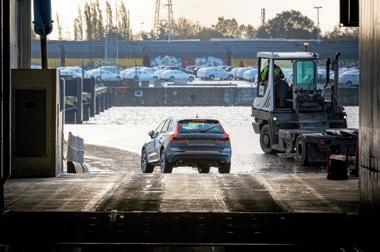
Photo courtesy of Volvo Cars.
All photos courtesy of MvH Group.
Working in port logistics, tasks like flling containers can be hard labour.

The personal approach
At North Sea Port, the human factor plays in important role, not in the least as around 100,000 individuals either directly or indirectly earn their living from activities in the port. Despite the ongoing automation and digitalisation, the input from experienced and skilled people is still essential.
To meet the demand for manpower, companies often make use of employment agencies that help with temporary workforce. One such company is MVH Group, founded on the year-long port-related work experience of owner Basiel Martinet. PortNews had an online Q&A meeting with him.
Q: Mr Martinet, can you tell us something about your company?
A: “My wife and I started MvH in 2012, with a focus on the employment of logistic workers. The M in the company name stands for Martinet and the vH for Van Helsland, which is the family name of my wife Ingeborg. Today, our offce has a staff of six people and we employ on average 60 people every day. We are a dedicated and ambitious company that acts locally, cross-border, and always with a personal approach. We operate in Flanders and the southwestern part of the Netherlands, including North Sea Port and the port of Moerdijk. We are currently seeking an expansion towards the port of Rotterdam as well.”
Q: Why did you decide to start MvH, as the competition in your market must be ferce?
A: “Before we started MvH, I had been working in logistics and shipping for 20 years in various roles. As a manager on vessels, loading trucks and vessels, driving trucks and reach stackers, managing stevedoring operations, and advising the arrangement of warehouses, I have done and seen it all on various levels in this industry. That is why I know what is going on in shipping and port logistics and cargo handling. I know what works well and what should be improved. In 2012, I decided to leave my job to start my own business. We now use this experience to fnd the exact match for both our employees and customers.”
Q: MvH as approximately 60 people working for the company. Why did they decide to join MvH, as there are also lots of other agencies?
A: “Indeed, we are not the only employment agency. However, what truly makes the difference is the fact that we take really good care of our team. We consider our employees to be the heart of our organisation. I have learned from experience how things can worsen. We provide our employees with a proper vehicle, working outft, and PPE. So, they always show up for work in a proper and safe fashion. We often receive ‘Fast and MvH delivers’ from our customers as feedback on our services. We can supply customers with skilled and trained, motivated, and certifed staff on short notice, as we have an up-to-date database of available job-seeking people. We can hence act fast to help our customers.”
Q: Apart from the abovementioned, where lie your other strengths?
A: “In port logistics, continuity, speed, fexibility, and certainty are extremely important. Like no other, we know our customers inside out, meaning that we know exactly what they need. We know our fex workers very well, too. We know their capabilities and what is also very important, we know how to keep them satisfed. As mentioned before, we take good care of them, from contract to the necessary training or certifcation. Furthermore, although digitalisation in the order sector is becoming increasingly important, we still like to personally stay in touch with our (potential) fex workers. We know people love to step into our offce in Hulst for information about job opportunities. This approach often leads to a direct result. People sometimes start the very next day. We are of course also visible online with our website and social media channels, as well as on the well-known job boards.”
Q: What challenges does MvH face?
A: “Working in port logistics, tasks like flling containers can be hard labour and we will probably reach a point where no one will be interested in this kind of work or that it is no longer allowed due to stricter labour regulations. Our goal is to be ahead of this moment. For this reason, we are, together with Flemish robotics expert Voxdale, currently working on a fully automatic and autonomous robot for loading and unloading containers. This robot is truly innovative, as it can autonomously and swiftly move goods in and out of containers. Through Link2Innovate and Crossroads, the project is recognised and subsidised by the European Interreg Flanders-Netherlands programme. This programme stimulates cross-border projects for smart, green, and inclusive growth, which is a valuable recognition of our project.”
MvH Group offers skilled and trained staff for a broad range of port logistics activities, including: • Stuffng and stripping of containers. • Loading and unloading trucks. • Order-picking. • Preparing shipments. • Repacking, labeling, and sealing parcels.

I. MVH-GROUP.COM
Together with Flemish robotics expert Voxdale, MvH Group is currently working on a fully automatic and autonomous robot for loading and unloading containers. “We consider our employees to be the heart of our organisation.”
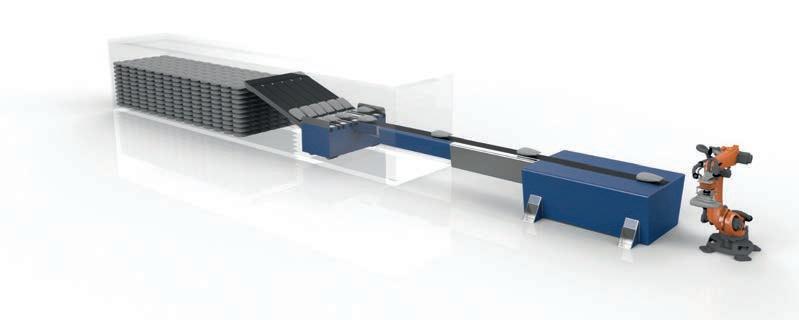
Building up volume(s)

Wijngaard Natie
Two years ago Wijngaard Natie gained a major foothold in the North Sea Port area with the take-over of a large warehouse for chemical logistics. The group renovated the installation, reorganised the operations, and expanded the range of activities. “We believe that business will continue its upward trend”, says Business Development Manager William De Keulenaer.
Wijngaard Natie only recently settled within North Sea Port, but is not a new kid on the block when it comes to logistics and port business. The group’s history stretches at least back to 1864, when the namesake company was offcially established in Antwerp, building on an even longer tradition. Today it is an important player in both stevedoring and warehousing. In the frst feld it runs a trimodal maritime terminal covering a total surface of 355,000m2 and 1,5km of quay length, comprising the only all-weather terminal in the port of Antwerp. With regard to warehousing, it can rely on 125,000m2 of stateof-art warehouses to offer a wide range of storage, value added and integrated distribution services for various cargo fows, with a specifc focus on food and feed products, chemicals, metals, and project cargo. The two main activities are supported by forwarding and transport departments, a container freight station, lashing & securing services, and spin offs like a division
Photo courtesy of Jean-Louis Vandevoorde.

for the tailor-made packing of maritime, airfreight or industrial cargo. The family-owned company employs 180 people, including the dock workers it hires daily for stevedoring purposes. In 2019 Wijngaard Natie considerably expanded its warehousing activities by acquiring the distribution centre for chemical products of the Ahlers group in Evergem, only a few yards away from the Kluizendok complex in Ghent. “It was our frst big step outside Antwerp. But in terms of infrastructure, equipment, knowhow, and certifcation, it was an excellent match for our existing facility in Kallo, on the Left Bank of the Scheldt River in Antwerp. Moreover, it offered us a chance to get closer to the important industrial cluster in the Ghent port area, with potential clients that ft the profles we aim at”, explains William De Keulenaer, Business Development Manager in charge of the Evergem site. “This was an opportunity to grow our business we simply could not miss. If we wanted to build such a warehouse, it would have taken us years to achieve a similar result.”
Partial reboot
The warehouse on the industrial site De Nest, which was renamed ECO Center Evergem, is 25,000m2 large. It is confgurated with one main hall of 14,200m2, and three units of 1,500 to 3,750m2. One of these compartments allows for high Seveso threshold storage of special classes of dangerous goods. Another one is equipped with narrow-aisle racks. Free height is 12 metres. The temperature and humidity controlled installation is ISO-certifed and is now also GMP+/FCA approved. The warehouse has a full foam sprinkler system, drainage and spill tanks, gas detection and measurement, access control, and 24/7 security and surveillance. The
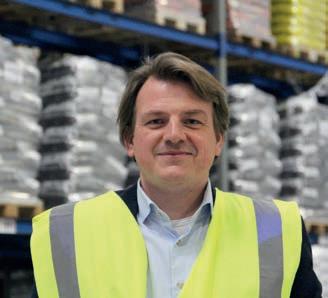
Photo courtesy of Jean-Louis Vandevoorde.
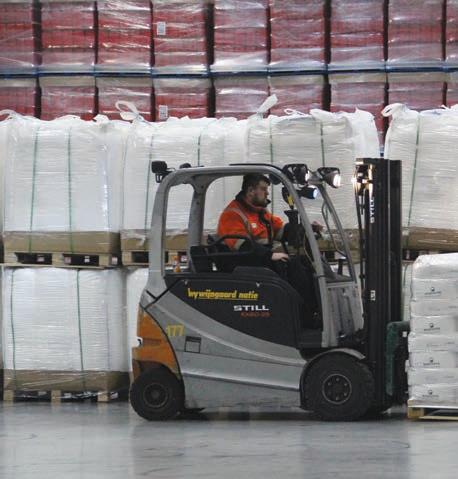
Business Development Manager William De Keulenaer.
infrastructure and equipment are regularly amended to the newest regulatory standards. The available space can be used either for rack or bulk storage of pallets. The loading and unloading docks each have eight gates where trucks and containers are handled. The operational mezzanines of 400m2 above them can serve as pick & pack zones or for other logistical purposes, and have their own offce rooms. The warehouse also has its own weighbridge. The offce building connected to the operational zone houses the customer service team that is in communication with clients and stakeholders daily. When taking over the site, Wijngaard Natie started by taking out the racks to renovate the foor. “In the frst year we operated a partial reboot of the warehouse and reorganised operations. So we frst took a step back, but we were up and running again and building up volume when the corona pandemic struck. We held our ground though, and were even able to attract new clients. We also fne-tuned the interaction with the Kallo site, which works both ways. Evergem is a better location for certain cargo fows”, Mr De Keulenaer sums up the past two years.
More fows
“We focus on industrial clients with specifc fows and needs. More specifcally, we now handle fve main kinds of commodities”, he adds. “Non-dangerous and dangerous chemicals are the two fows we started out with. We are a well-known player within the industry and our facility is tailored to the needs of the chemical sector and meets the higher standards that these clients expect and require. There are a lot of chemical plants in the immediate surroundings. We are aiming at getting them to know us better and attracting more business with them.” Food is the second big pillar of activity for Wijngaard Natie in Evergem. “We are already active in this sector in our ECO Center Kallo, and extended the licence for packed food products delivered to us by the Federal Agency for the Safety of the Food Chain to our site here. In this area, we thus obtained a full organic certifcation to store and handle these types of products.” Food led to feed. “Animal feed is a booming activity. Quality and reliability standards are set ever higher in this sector, which also increasingly relies on dangerous goods in its production for the animal nutrition and petfood market. It has the added advantage that it is a pretty stable activity. For this industry, we
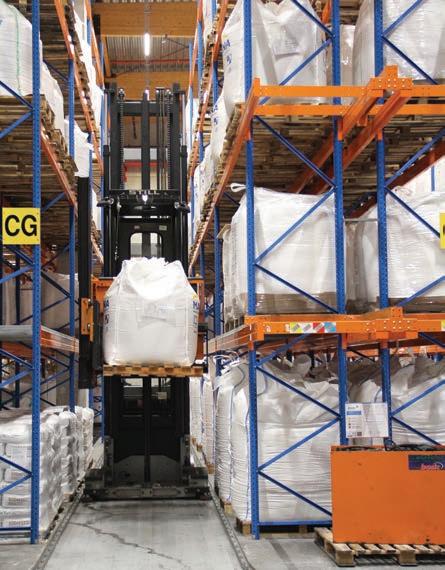
Photo courtesy of Jean-Louis Vandevoorde.
All goods are moved in and out on pallets.

The Wijngaard Natie warehouse is by far the biggest building on the industrial site De Nest in Evergem.

Photo courtesy of Wijngaard Natie
Acquiring this warehouse was an opportunity to grow our Wijngaard Natie business that we simply could not miss.
act both as a consolidation warehouse for all incoming raw materials and with a daily product shuttle to a nearby factory. Secondly, export fows are organised from our warehouse, including document and physical verifcation by customs, veterinary inspection, and so on.” Food and feed are well represented within North Sea Port as well. “And then there are the ‘why nots’”, says the Business Development Manager of Wijngaard Natie with a smile. “Oneshots which can complement our activity during a certain period and for which we have available capacity. Since we have not reached full capacity yet, there is still room for this kind of operations. This is not something we are actively pursuing, but if such an opportunity arises… We are also always willing to help out with smaller volumes that other players may not be interested in.” “Of course, we never combine fows that are not compatible. Every fow is checked for the potential risk of contamination. We ask for the complete information on the product and screen it thoroughly to make sure it fts the requisites of our licences to operate and does not constitute any danger in combination with other goods we store and handle.”
More services
“Next to the existing activities of typical warehousing services, we are open to developing new activities where possible, in close cooperation with our clients and network. Moreover, we can rely on our experience and know-how regarding these services, which we acquired in the Kallo setup. The diversifcation in fows will in due time be followed by diversifcation in services. For the time being, in Evergem we limit ourselves to offering the basic functions a warehouse offers: loading and unloading, storage, sampling, relabelling, (re)palletising, and the likes. So far, we do not act on the product itself, even if we had demands to take care of bagging products delivered to us in big bags, to name just one example. That will come in due time, but requires investments which need to be justifed by long-term engagements by clients.” Incoming and outgoing volumes, even when talking about big bags or IBC containers, all move on pallets. Chemicals globally account for about 40% of the volumes handled, animal feeds for 25%. “It makes for a healthier balance that enables us to balance the ups-and-downs in our different trades.” There is still ample room for additional volumes, William De Keulenaer concedes. “We are on an adequate level of truck handlings and material movements on a daily basis, but have not yet reached our maximum level. We still have plenty of capacity to offer. We have room for a solid 24,000 pallets.” He rates the present occupancy rate at 50%. “But even though the pandemic did not hit us too hard in Evergem, we had to build business up again. So we are quite happy with our progress and have reasons to believe that the business will continue its upward trend.”
Excellent location
“Our location helps us a lot in this respect. North Sea Port is an important industrial hub and is geographically very well located to serve markets like the North of France, the Netherlands, the United Kingdom, and others The maritime link with Scandinavia is excellent. Rail and water connections are available at the nearby Kluizendok if required by the customer. We are confdent we will be able to make the most of these advantages. And as traffc goes up, so will employment, which already stands at ffteen people.” Investing in a new Warehouse Management System (WMS) will give an extra push. “Our frst target is to optimise our operational and fnancial performance. We are not in a position to do everything. We choose to focus on the right fows and clients, and to reinforce relations with the surrounding market. Corona is not helping in this respect, but we are confdent that this approach will pay off.”





